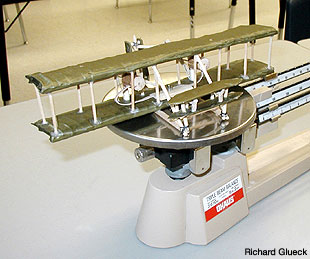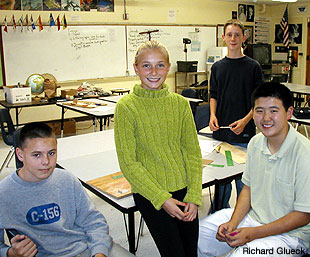|
|

|
Wright Flyer model soars in space
by James Oberg, MSNBC

May 20, 2003 — When the international space station's relief crew arrived last month, their luggage included an extra, last-minute item: a scale model of the famous Wright Flyer biplane, intended to commemorate the 100th anniversary of heavier-than-air flight. Next week, the astronauts finally get their chance to show it off.
Built by middle-school students in Maine, the model has a wingspan of 10 inches (25 centimeters) and weighs less than 2 ounces (57 grams). NASA said space station crew members Edward Lu and Yuri Malenchenko will put it through a zero-G demonstration next week as part of the space agency's "Educational Payloads" program, which also involves paper-airplane flights and the playing of a pu'ili, a small Hawaiian flute.
Science teacher Richard Glueck of Orono Middle School in Orono, Maine, oversaw the construction of the replica for a special NASA "flight opportunity," originally offered on a shuttle launch. The Centennial of Flight Commission requested a small Wright Flyer model built to spaceworthy specifications.
Glueck told MSNBC.com that it had to be "lightweight, unobtrusive and safe for a mission to the ISS." Furthermore, he continued, "It could not be powered by electricity or fuel, could not have exposed sharp edges, could not outgas vapors in microgravity, and not clutter the station."

He and his students fabricated and delivered two flight units and were making plans to attend the shuttle launch in July when the Columbia catastrophe on Feb. 1 grounded all shuttle missions. Then an opportunity arose to stash the model and its special launch container inside the Russian Soyuz vehicle that was reassigned to carry the station's replacement crew.
Up until the Soyuz's launch day on April 26, nobody knew if the Russians would fly the model.
"We were waiting to see if there was any room left," said Alan Holt, a NASA payload integration manager in Houston. He told MSNBC.com that the model was taken to Russia's Baikonur Cosmodrome in Kazakhstan two days before liftoff.
Only hours before launch, as Russian technicians stashed the final assortment of optional cargo items in the spacecraft's nooks and crannies, did Glueck learn that a suitable location had been found and the model was aboard.
"They did not displace anything," Holt explained. "They could have fit in a corner here or there" - and that's apparently exactly what they did.
A Decade Of Replicas
Glueck has been having his sixth-grade geometry students make aerospace replicas since 1990. They started with refrigerator cardboard mockups of Mercury and Gemini capsules, and soon got on national TV.
In the years that followed, Glueck's pupils built a flying replica of the Wright 1902 glider, the bicycle-powered 1878 Ritchel Airship, a hot-air balloon, two 1896 Chanute gliders, an M2F2 "lifting body" mockup, a full-size shuttle flight deck, two Apollo spacewalk suits, Bell tetrahedral kites, the Wright 1900 glider and a half-size Wright 1902 glider. The latter two are now at NASA's Glenn Research Center in Cleveland, where they are used for educational training.
"When the projects are built, each student calculates the measurements using fractions, proportions, and ratios," Glueck told MSNBC.com. "The measurements are then corrected against historical information, and scaled up - and every student builds a scale model from their own plans."
Glueck's classroom has about 50 tissue-and-balsa Wright Flyers hanging from the ceiling.
Powered by Rubber Bands
Glueck explained that the space-bound replica was hand-built using what was readily available - birch coffee stirrers, toothpicks, white glue and rip-stop nylon. It has precisely balanced propellers and a propulsion system powered by a rubber band.
"The model was completed in 10 days to meet NASA's requirements," he told MSNBC.com, "and packed off to a review board." The replica was accepted, but NASA then told Glueck that they needed a second replica to actually fly.
"The kids pulled it out again, and produced a second edition," he proudly stated.
Once NASA had the flight item, their own engineers built a special cushioning container to hold it during launch. It was designed to handle the 3 g's of a shuttle launch. But when the payload was switched to the Soyuz, the Russians told NASA they couldn't guarantee safe delivery due to the higher G-forces. NASA agreed to take the chance.
The preceding first appeared on MSNBC. It is reprinted with permission of the author. |
back to News

© 2023 collectSPACE.com All rights reserved.
Questions? E-mail [email protected]

|
|

|

|
